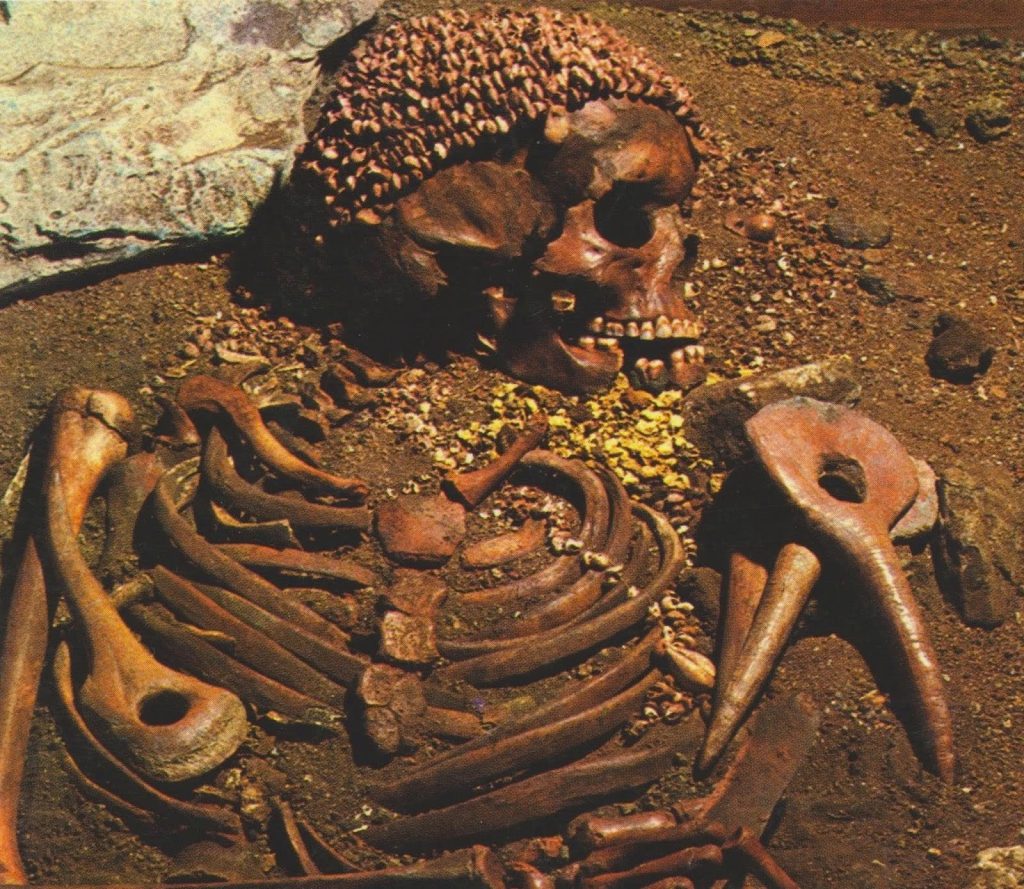Nestled in the rugged cliffs between Italy and France lies a series of caves known as the Balzi Rossi, or the Grimaldi Caves. These natural caverns, positioned along the breathtaking Mediterranean coast, have intrigued archaeologists and historians for well over a century. Within their rocky interiors lies an extraordinary wealth of prehistoric artifacts and human remains, offering an invaluable window into the lives of our ancient ancestors. These findings continue to redefine our understanding of human evolution and the early societies that shaped our species.
The Lady of Caviglione: A Glimpse into Gravettian Burial Practices
The story of the Balzi Rossi began to unfold in the 1870s when a French doctor, Emile Rivière, made a groundbreaking discovery within one of the caves. Rivière unearthed the remains of a woman who had been carefully buried, her body adorned with ornaments and surrounded by grave goods. Dubbed the “Lady of Caviglione,” this find provided a rare and detailed glimpse into the burial customs of the Gravettian people, who lived approximately 24,000 years ago. The discovery offered more than just an anthropological curiosity—it illuminated the spiritual and ceremonial practices of a community that lived tens of millennia before our time.

The Venus Figurines: Early Artistry of Humanity
While Rivière’s discovery was captivating, it was in 1883 that the Balzi Rossi gained global attention. Louis-Alexandre Jullien, a merchant from Marseille, collaborated with local enthusiast Stanislas Bonfils to excavate further. Their work uncovered a series of small statuettes depicting nude female figures, unlike anything previously identified from the Paleolithic era. These artifacts, later known as “Venus figurines,” sparked immense fascination across the scientific community and beyond.
Jullien was initially hesitant to publicize his findings, fearing skepticism about their authenticity. However, as the figurines gradually found their way into museums and private collections, they became celebrated examples of early human artistry. Representing fertility and femininity, these figurines underscored the symbolic and cultural richness of the people who created them.
The Vanishing and Rediscovery of the “Mothers of Time”
Jullien’s excavations yielded over 15 Venus figurines, forming a collection that came to be known as the “Mothers of Time.” However, following his death, these priceless artifacts were lost to history for decades, their whereabouts shrouded in mystery. It wasn’t until the 1980s and 1990s that these figurines reemerged, scattered across various locations. Ultimately, they were reunited and displayed as a cohesive collection, their haunting beauty captivating audiences and rekindling interest in the enigmatic artisans who created them.
The Balzi Rossi caves are more than a repository of fascinating objects—they are a living museum chronicling tens of thousands of years of human history. The caves’ layers of sediment preserve a detailed narrative, spanning from the era of Neanderthals to the advent of early modern humans, who would eventually become our direct ancestors. Stone tools, elaborate burials, and delicate cave engravings provide glimpses into the intellectual and cultural lives of these prehistoric communities. Each layer of sediment offers a chapter of this long story, illustrating the progression of human ingenuity, creativity, and adaptation.
One of the most compelling aspects of the Balzi Rossi is its role in showcasing the spiritual lives of early humans. From the intricately adorned burial sites to the symbolic engravings on cave walls, the evidence suggests a community deeply connected to ritual and meaning. These findings challenge the notion that early humans were solely focused on survival, revealing instead a people rich in culture and imagination.
Ongoing Excavations: Unlocking New Mysteries
The story of the Balzi Rossi is far from complete. Archaeologists continue to study the caves, uncovering new artifacts and piecing together the puzzle of early human life. Recent excavations have revealed additional burial sites, further elaborating on the complex rituals practiced by these communities. Advances in technology, such as radiocarbon dating and DNA analysis, allow researchers to extract more precise information from these ancient finds, shedding light on migration patterns, dietary habits, and social structures.
The continued exploration of the Balzi Rossi serves as a reminder of the enduring relevance of archaeology in understanding our shared history. Each discovery brings humanity closer to understanding the critical transition periods that shaped modern humans, particularly the moment when they began to establish themselves across Europe. The caves’ treasures demonstrate the adaptability and resilience of early humans, attributes that allowed our species to thrive in the face of changing climates and environments.
A Legacy of Wonder and Insight
The discoveries made at the Balzi Rossi transcend mere academic interest; they are a testament to the enduring legacy of human curiosity and creativity. These ancient artifacts and the stories they tell resonate deeply with modern audiences, bridging the vast expanse of time that separates us from our prehistoric ancestors. They remind us that the fundamental aspects of humanity—ingenuity, artistry, and a desire for connection—have persisted throughout the millennia.
As new findings emerge, the Balzi Rossi continues to inspire wonder and curiosity, inviting us to explore the roots of our shared heritage. This remarkable site stands as both a physical and symbolic link to the past, offering profound insights into the lives of those who came before us. By studying these ancient secrets, we gain a deeper appreciation for the richness of human history and the incredible journey that has brought us to where we are today.
The story of the Balzi Rossi is an ongoing narrative of discovery and revelation. Each artifact unearthed, each burial site examined, and each layer of sediment analyzed brings us closer to understanding the intricate tapestry of human evolution. Through the caves of Balzi Rossi, we glimpse the lives, struggles, and triumphs of our distant ancestors, reminding us of the enduring connection that binds all of humanity across the ages.





